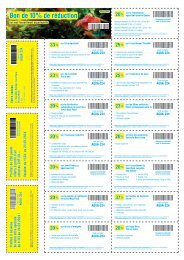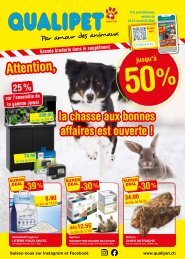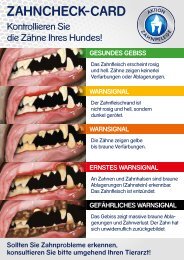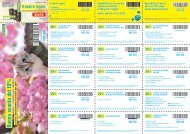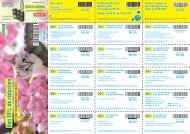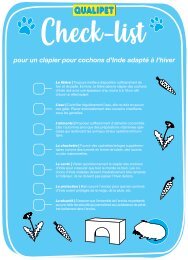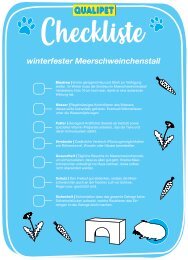Erste Hilfe für Hunde und Katzen
Sie wollen auch ein ePaper? Erhöhen Sie die Reichweite Ihrer Titel.
YUMPU macht aus Druck-PDFs automatisch weboptimierte ePaper, die Google liebt.
E<br />
• pale mucous membranes<br />
• tongue becomes bluish from lack of oxygen<br />
• capillary filling time is more than 2 seconds<br />
• pet body temperature decreases (noticeable at the limbs)<br />
In case of shock the pet should be taken to the vet as soon as possible, where the pet<br />
will be provided with hydration infusions and other specific medical treatment.<br />
What to do:<br />
1. Heavy bleeding should be stilled with a pressure bandage (see picture<br />
page 6).<br />
2. Cover your pet with an emergency blanket to avoid loss of body heat.<br />
3. Calm your pet.<br />
4. How to lay your pet in case of shock: Put the pet’s back on a slightly raised pad.<br />
This increases the blood supply to heart, lungs and brain. If your pet shows too<br />
much pain, please refrain from placing it in the shock position.<br />
Moving the pet for transport has to be done with care since every change of position<br />
will put heavy strain on the pet’s blood circulation.<br />
Open wo<strong>und</strong>s<br />
Wo<strong>und</strong>s which are tended to quickly heal well. How to treat them depends on the<br />
type of wo<strong>und</strong>.<br />
Bites<br />
Bites are contaminated by germs which are located in every pet’s mouth and this<br />
can lead to blood poisoning in the most serious cases. Therefore it is advisable to see<br />
a vet if possible, in order to prevent the wo<strong>und</strong> from getting infected but to treat it<br />
appropriately.<br />
Abrasions (injury to the outer layer of skin)<br />
Let the wo<strong>und</strong> bleed slightly so that impurities can be washed out. In case of large<br />
impurities, the wo<strong>und</strong> should be disinfected, e.g. with antiseptic wipes. Normally<br />
abrasions heal by themselves within a few days. A little protective bandage or a<br />
veterinary collar can prevent contamination by germs or irritation from licking.<br />
Cuts<br />
Cuts are often located in the paw area. This happens e.g. when a pet steps on a<br />
piece of broken glass. Any foreign matter such as shards of glass can be removed<br />
carefully with tweezers. Then the paw should be covered and bandaged as sterilely<br />
as possible.<br />
How to put on a short-time paw bandage (see picture page 6)<br />
Begin below the paw and pull the bandage to the front over the claws and then over<br />
the whole paw. Next wind the bandage roll aro<strong>und</strong> the leg in circular movements,<br />
13









